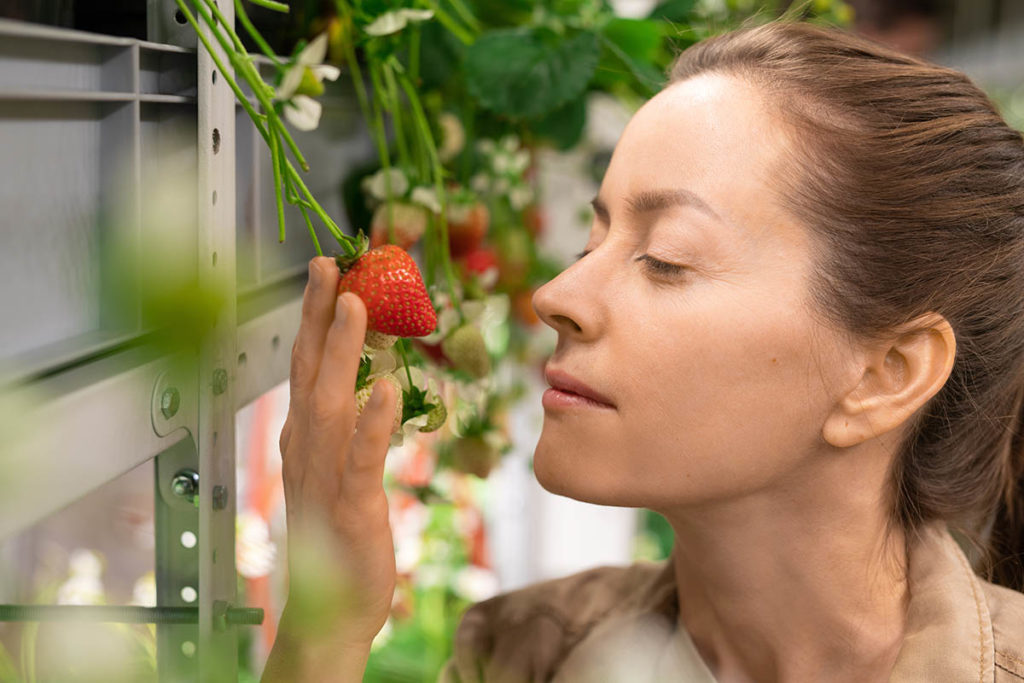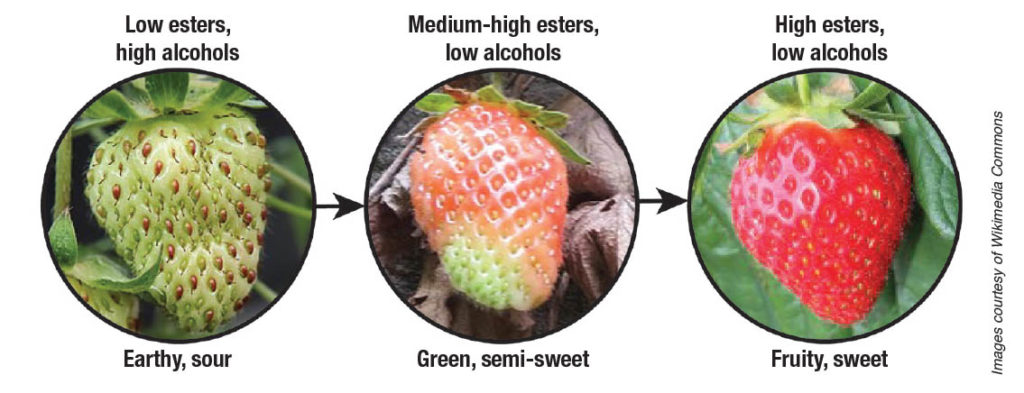By Kristen Van Gelder
Strawberries are liked for their sweetness, flavor and delicious aroma. Both sweetness and aroma vary among cultivars and are influenced by the environment during growth, harvest and post-harvest storage. Strawberry consumers tend to favor fruit with intense sweetness and a fragrant, fresh and fruity aroma. In contrast, consumers tend to dislike strawberries that are sour and have a green, earthy or woody aroma.

The driver behind sweetness in strawberries is the sugar called sucrose. Efforts to breed strawberries for higher concentrations of sucrose led to negative outcomes for yield and firmness of the fruit. So, how can strawberries be bred for improved sweetness when simply increasing the sucrose level in the fruit is not an option? By breeding for aroma!
THE POWER OF AROMA
Even when sucrose content is low in some strawberry cultivars, consumers perceive them to be sweet due to the more intense fruity scent. But which aromas cause the fruitier scent of strawberries? And how is this linked to perception of increased sweetness?
The aroma of strawberries comes from small volatile compounds. These compounds readily evaporate at normal temperatures. Some volatiles smell fruity, and others can smell woody or earthy. When you eat a strawberry, the volatile compounds waft into your nasal passages, and together with your taste buds, send signals to your brain about the flavor. Strawberries with fruitier aromas are often perceived as sweet, whereas strawberries with a woody or earthy aroma may be perceived as sour.
VOLATILE TYPES
The volatiles with a pleasant fruity scent are called esters and are most associated with sweetness regardless of sucrose content. For example, cultivars with low sucrose but high amounts of esters may be perceived as sweeter than cultivars with the same amount of sucrose but lower esters at maturity. Other volatiles that can contribute to the fruity aroma of strawberries are aldehydes and ketones. On the other hand, volatiles associated with woody or earthy aromas include alcohols and acids.
INFLUENCING FACTORS
Volatile content also depends on environmental conditions and stage of growth. For example, strawberries grown in Florida during the winter are often sweeter than strawberries grown in summer in Europe, due to the cooler temperatures, particularly at night. Lower temperatures increase volatile levels. As the temperature warms from the months of January to March, the volatile content decreases.
The stage of maturity of the fruit also influences volatile levels. Fully mature red fruit can have up to five times more volatiles than immature pink fruit. However, there can be an almost 14-fold increase in volatile content when the fruit mature from white to pink. This is largely due to the rise in esters as the fruit ripens, which is accompanied by a fall in alcohols.

Additionally, post-harvest storage conditions can affect volatile content. Whether the fruit is harvested at the pink or the red stage, volatile content increases during storage, particularly at a cool storage temperature, such as 59 degrees. Even more important to volatile level is the presence of oxygen. Low-oxygen storage conditions result in the production of ethanol, leading to fruit having a sour, off-flavor often associated with an over-ripe, fermented taste.
CONCLUSION
To sum up: Consumers like strawberries when they are sweet and fruity. As the fruity aroma is perceived as sweetness, breeding strawberries for increased volatile concentrations (particularly esters) can greatly increase consumer perceptions of sweetness and overall likability without impacting yield or fruit firmness.
Kristen Van Gelder is a postdoctoral researcher in the Horticultural Sciences Department at the University of Florida in Gainesville.









